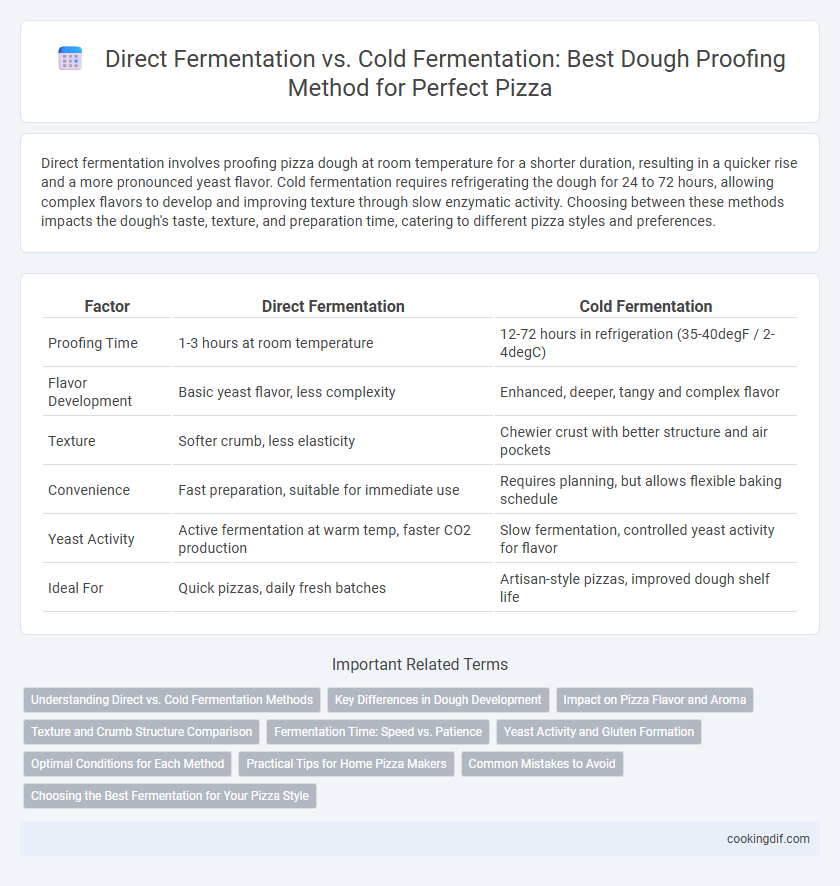Direct fermentation involves proofing pizza dough at room temperature for a shorter duration, resulting in a quicker rise and a more pronounced yeast flavor. Cold fermentation requires refrigerating the dough for 24 to 72 hours, allowing complex flavors to develop and improving texture through slow enzymatic activity. Choosing between these methods impacts the dough's taste, texture, and preparation time, catering to different pizza styles and preferences.
Table of Comparison
| Factor | Direct Fermentation | Cold Fermentation |
|---|---|---|
| Proofing Time | 1-3 hours at room temperature | 12-72 hours in refrigeration (35-40degF / 2-4degC) |
| Flavor Development | Basic yeast flavor, less complexity | Enhanced, deeper, tangy and complex flavor |
| Texture | Softer crumb, less elasticity | Chewier crust with better structure and air pockets |
| Convenience | Fast preparation, suitable for immediate use | Requires planning, but allows flexible baking schedule |
| Yeast Activity | Active fermentation at warm temp, faster CO2 production | Slow fermentation, controlled yeast activity for flavor |
| Ideal For | Quick pizzas, daily fresh batches | Artisan-style pizzas, improved dough shelf life |
Understanding Direct vs. Cold Fermentation Methods
Direct fermentation involves proofing the dough at room temperature for a few hours, resulting in a faster process but less developed flavors, while cold fermentation slows yeast activity by proofing the dough in a refrigerator for 24 to 72 hours, enhancing complexity and texture. Cold fermentation allows enzymes to break down starches and proteins slowly, producing a dough with superior taste, aroma, and a chewier crust. Understanding the impact of fermentation time and temperature is crucial for achieving the desired balance between quick preparation and rich, nuanced flavor in pizza dough.
Key Differences in Dough Development
Direct fermentation accelerates dough proofing by using warm temperatures, resulting in a quicker rise and a softer, less complex crumb structure. Cold fermentation slows yeast activity at low temperatures, enhancing flavor complexity through prolonged enzymatic reactions and creating a chewier, more developed crust texture. The choice between methods impacts dough extensibility, gluten development, and final pizza taste profile.
Impact on Pizza Flavor and Aroma
Direct fermentation produces a faster dough proofing process, resulting in a simpler, yeasty flavor with less depth in aroma. Cold fermentation, typically lasting 24 to 72 hours, enhances the development of organic acids and complex flavor compounds, contributing to a richer, tangier taste and a more aromatic crust. The slow enzymatic activity during cold fermentation improves dough extensibility and produces subtle nutty and slightly sour notes that are highly prized in artisanal pizza.
Texture and Crumb Structure Comparison
Direct fermentation produces pizza dough with a denser crumb and slightly chewier texture due to shorter proofing times and higher fermentation temperatures. Cold fermentation enhances flavor complexity and results in a more open crumb structure with greater elasticity, as the extended slow fermentation allows gluten to develop more fully. Bakers often prefer cold-fermented dough for artisanal pizzas where a light, airy crust with nuanced taste and superior texture is desired.
Fermentation Time: Speed vs. Patience
Direct fermentation accelerates dough proofing, typically completing within 1 to 2 hours, allowing for quick pizza preparation but sometimes at the cost of flavor development. Cold fermentation involves chilling the dough between 24 to 72 hours, promoting complex flavors and improved texture through slow yeast activity. Balancing fermentation time is crucial for achieving desired dough characteristics, with cold fermentation favored for artisanal pizzas seeking depth in taste.
Yeast Activity and Gluten Formation
Direct fermentation involves yeast activating quickly at room temperature, producing carbon dioxide that expands the dough and develops gluten structure rapidly, resulting in a softer, less complex flavor. Cold fermentation slows yeast activity by refrigerating the dough for 24-72 hours, enhancing gluten strength through gradual protein bonding and creating more nuanced flavors due to extended enzymatic reactions. Adjusting proofing method directly impacts yeast metabolism rates and gluten matrix formation, essential factors for achieving desired pizza crust texture and taste.
Optimal Conditions for Each Method
Direct fermentation requires a warm environment around 75degF (24degC) with proofing times typically ranging from 1 to 3 hours, allowing the yeast to rapidly activate and produce a soft, airy dough. Cold fermentation demands refrigeration at temperatures between 38degF and 45degF (3degC to 7degC) for extended periods, often 24 to 72 hours, which slows yeast activity and enhances flavor development and dough strength. Optimal conditions for each method depend on desired dough characteristics: direct fermentation favors quick preparation and lighter texture, while cold fermentation improves taste complexity and crust structure.
Practical Tips for Home Pizza Makers
Direct fermentation uses room temperature proofing for 1 to 2 hours, ideal for quick pizza making with a softer crust. Cold fermentation involves refrigerating dough for 24 to 72 hours, enhancing flavor and developing a chewier texture through slow yeast activity. To optimize results, shape dough balls right after mixing for cold fermentation and allow direct fermentation dough to rise in a warm area for consistent proofing.
Common Mistakes to Avoid
Direct fermentation often leads to underdeveloped flavors and dense crust due to insufficient proofing time, while cold fermentation risks over-proofing if left too long in the refrigerator. Avoid using excessively warm water in direct fermentation, which can kill yeast and hinder dough rise, and never skip properly sealing dough during cold fermentation to prevent drying out. Precise timing and temperature control are crucial to prevent common mistakes like poor texture and inconsistent fermentation results in pizza dough.
Choosing the Best Fermentation for Your Pizza Style
Direct fermentation produces dough ready within hours, ideal for thin-crust pizzas requiring a light, airy texture with mild flavor. Cold fermentation extends proofing in the refrigerator for 24-72 hours, enhancing gluten development and deepening the dough's complex, tangy taste, perfect for Neapolitan and artisan-style pizzas. Selecting the best fermentation depends on desired crust characteristics and preparation time, with cold fermentation favored for richer flavor profiles and direct fermentation suited for quick, everyday pizza making.
Direct fermentation vs Cold fermentation for dough proofing Infographic

 cookingdif.com
cookingdif.com